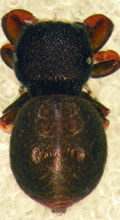Latest News Archive
Please select Category, Year, and then Month to display items
![]()
The UFS is continuously working to ensure that you are kept abreast of important critical information. It is therefore important that the cellphone number you are using is updated to reflect your current correct number.
To update your cellphone number, please go to the UFS self-service portal at https://www.ufs.ac.za/kovsielife/student-self-service OR contact
the Call Centre at +27 51 401 9666. Please provide the following information to the call centre agent:
– your initials, surname, student number, cellphone number, email address, and physical address.
Monitor the official UFS communication platforms regularly for important information, and please stay safe during this lockdown period.
UFS entomologists describe a new spider species
2014-02-19
|
 |
It is about 3mm in size and almost looks like a ladybird, but this new spider is the cause of great excitement at the University of the Free State’s (UFS’s) Department of Zoology and Entomology.
The new species of spider, now known as Rhene amanzi, was recently described for the first time and was ‘introduced’ to other arachnologist at the recent congress of the African Arachnology Society at Amanzi Private Reserve.
Dr Charles Haddad, senior lecturer in the UFS’s Department of Zoology and Entomology, said they already stumbled upon the male spider in 2010 when a student was doing research at the reserve. After a very long process, the spider was described and a couple of weeks ago, whilst at the congress, they also found the female.
“Up to now we only know that the spider lives in trees in the Brandfort area. The range could be wider, but since it was only described recently, other arachnologists will only now be able to identify accurately.”
Dr Haddad says they still have to determine how many eggs the female is able to lay, what the spider’s life cycle looks like and what their habitual preferences are.
“What we do know is that it probably isn’t poisonous and that the spider imitates a ladybird in order to protect itself against predators.”